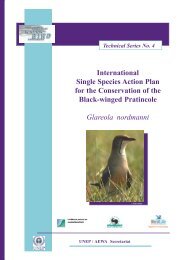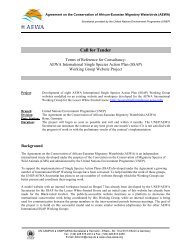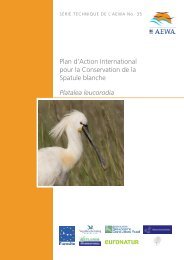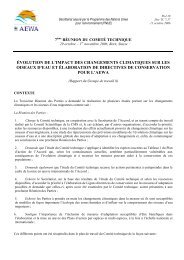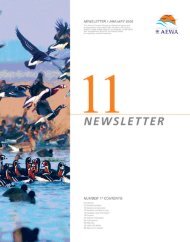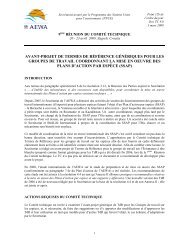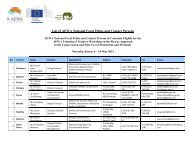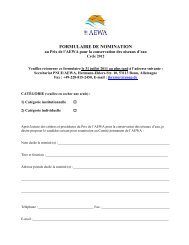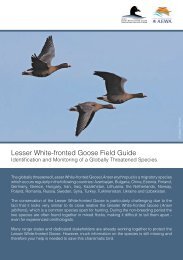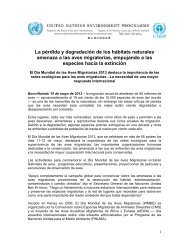International Single Species Action Plan for the ... - AEWA
International Single Species Action Plan for the ... - AEWA
International Single Species Action Plan for the ... - AEWA
You also want an ePaper? Increase the reach of your titles
YUMPU automatically turns print PDFs into web optimized ePapers that Google loves.
<strong>AEWA</strong> Technical Series No. 36<br />
6. Activities<br />
Result 1: Mortality rates are reduced<br />
The most important and most urgent activities under this <strong>Action</strong> <strong>Plan</strong> are those aimed at<br />
halting <strong>the</strong> currently unsustainable (and mostly illegal) hunting pressure on Lesser Whitefronted<br />
Geese:<br />
1. Ensure that, in principle, hunting legislation af<strong>for</strong>ds adequate protection to Lesser<br />
White-fronted Goose;<br />
2. Ensure that sufficient human and financial resources are allocated <strong>for</strong> en<strong>for</strong>cement of<br />
hunting legislation, and that <strong>the</strong>se resources are deployed to control and manage<br />
hunting effectively and sustainably;<br />
3. Ensure that sufficient human and financial resources are allocated <strong>for</strong> identifying <strong>the</strong><br />
traditional flyway and stop-over sites, and making that flyway safe <strong>for</strong> <strong>the</strong> geese.<br />
4. Ban goose hunting at all key sites <strong>for</strong> Lesser White-fronted Goose (as listed in Annex<br />
3 to this <strong>Action</strong> <strong>Plan</strong>) during <strong>the</strong> period when Lesser White-fronts are usually present,<br />
given <strong>the</strong> difficulty of reliably distinguishing goose species in flight (especially <strong>the</strong><br />
near impossibility of separating Greater and Lesser White-fronts, even from relatively<br />
close range and in good light);<br />
5. <strong>Plan</strong>t lure crops to direct Lesser White-fronted Goose away from areas where hunting<br />
pressure is known to be high and towards refuge zones;<br />
6. As far as possible, redirect hunting from adults to juveniles in areas where Greater<br />
White-fronts and Lesser White-fronts occur toge<strong>the</strong>r away from key sites.<br />
7. Implement obligatory training as outlined by <strong>the</strong> Hunting Charter of <strong>the</strong> Bern<br />
Convention (Nov 2007) <strong>for</strong> hunters particularly in Eastern European countries.<br />
8. Carry out an in<strong>for</strong>mation campaign to engage local and European hunting<br />
organisations and nature protection NGOs.<br />
9. Upgrade level of protection from illegal hunting within existing protected areas<br />
through training and improved en<strong>for</strong>cement.<br />
These actions are applicable in all Range States, but especially in those countries of <strong>the</strong><br />
staging and wintering range where hunting pressure is known to be particularly high, e.g.<br />
Kazakhstan, Russian Federation, Ukraine.<br />
In addition to <strong>the</strong>se measures, it has been suggested that ef<strong>for</strong>ts should continue to establish a<br />
safer migration route, while giving <strong>the</strong> highest possible priority to <strong>the</strong> protection needs of <strong>the</strong><br />
existing wild population (see Result 4 below). However, <strong>the</strong> November 2005<br />
recommendation of <strong>the</strong> Scientific Council of <strong>the</strong> Convention on Migratory <strong>Species</strong>, combined<br />
with <strong>the</strong> conclusions of <strong>the</strong> January 2007 <strong>AEWA</strong> Secretariat negotation mission (see pages<br />
34–37 <strong>for</strong> details), mean that proposals have been deferred <strong>for</strong> at least three years (i.e. 2010 or<br />
later) to enable sufficient captive-reared stock derived exclusively from wild-caught birds to<br />
be built up.<br />
Result 2: Fur<strong>the</strong>r habitat loss and degradation is prevented<br />
Measures to halt and reverse habitat loss and degradation, and to maximise positive site<br />
management, will serve to underpin increased survival of full-grown birds achieved through<br />
<strong>the</strong> hunting-control measures outlined above.<br />
1. Ensure that all key sites <strong>for</strong> Lesser White-fronted Goose (breeding, staging and<br />
wintering) are af<strong>for</strong>ded appropriate protected area status at national and international<br />
levels, including classification as Special Protection Areas in EU Member States;<br />
<strong>International</strong> <strong>Single</strong> <strong>Species</strong> <strong>Action</strong> <strong>Plan</strong> <strong>for</strong> <strong>the</strong> Conservation of <strong>the</strong> Lesser White-fronted Goose 51



